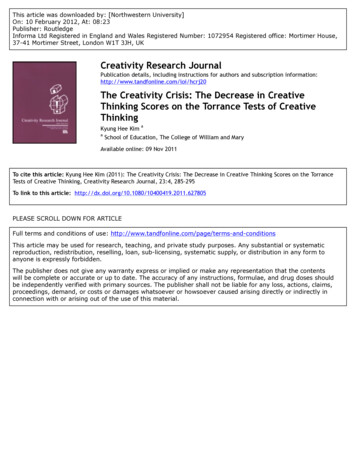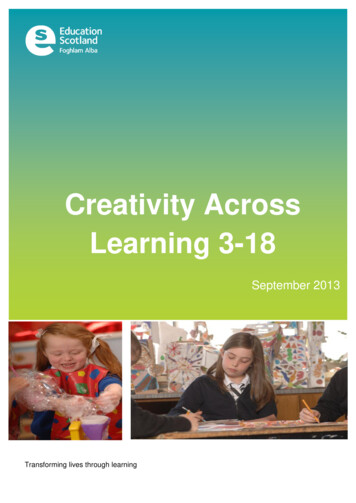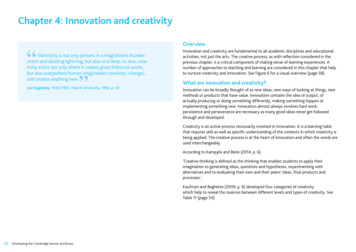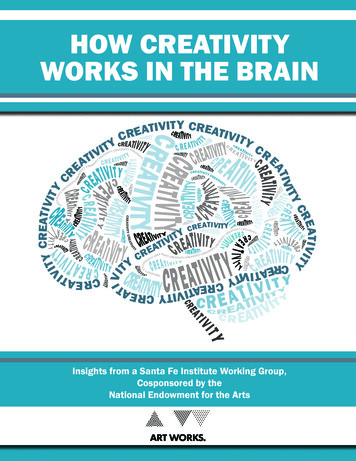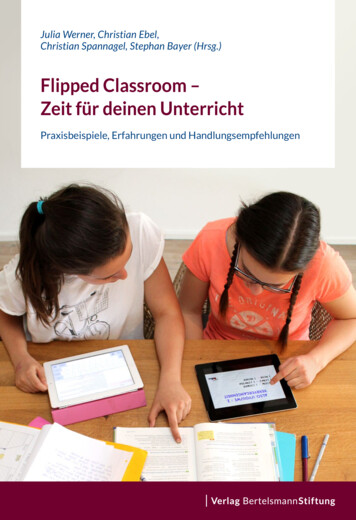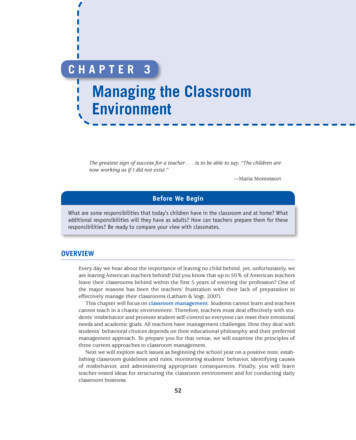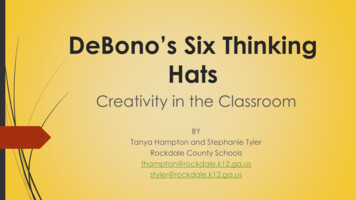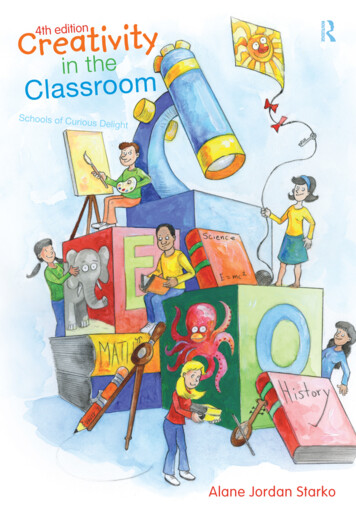
Transcription
Creativity in the ClassroomSchools of Curious DelightFourth EditionAlane Jordan Starko
First edition published 1995by Longman Publishers USASecond edition published 2001Third edition published 2005by Lawrence Erlbaum Associates, Inc.This edition published 2010by Routledge270 Madison Ave, New York, NY 10016Simultaneously published in the UKby Routledge2 Park Square, Milton Park, Abingdon, Oxon OX14 4RNRoutledge is an imprint of the Taylor & Francis Group, an informa businessThis edition published in the Taylor & Francis e-Library, 2009.To purchase your own copy of this or any of Taylor & Francis or Routledge’scollection of thousands of eBooks please go to www.eBookstore.tandf.co.uk. 1995 Longman Publishers USA 2001, 2005 Lawrence Erlbaum Associates, Inc. 2010 Taylor & FrancisAll rights reserved. No part of this book may be reprinted or reproduced or utilised in any form or by any electronic,mechanical, or other means, now known or hereafter invented, including photocopying and recording, or in anyinformation storage or retrieval system, without permission in writing from the publishers.Trademark Notice: Product or corporate names may be trademarks or registered trademarks, and are used only foridentification and explanation without intent to infringe.Library of Congress Cataloging in Publication DataStarko, Alane J.Creativity in the classroom : schools of curious delight / Alane Jordan Starko. — 4th ed.p. cm.Includes bibliographical references and index.1. Creative thinking. I. Title.LB1062.S77 2009370.15’7—dc222009008818ISBN 0-203-87149-9 Master e-book ISBNISBN 10: 0-415-99706-2 (hbk)ISBN 10: 0-415-99707-0 (pbk)ISBN 10: 0-203-87149-9 (ebk)ISBN 13: 978-0-415-99706-5 (hbk)ISBN 13: 978-0-415-99707-2 (pbk)ISBN 13: 978-0-203-87149-2 (ebk)
To the Hansen children—whose energy and creativity forcemy imagination into overdriveandAs always, to my grandmother Gwen—every good thingI’ve done can be traced, in the end, back to her
ContentsPreface: Why Creativity in the Classroom?ixPart I Understanding Creative People and Processes11What Is Creativity?2Models of the Creative Process213Theories of Creativity: The Individual454Theories of Creativity: Systems in Context635Creative People81Part II Creativity and Classroom Life31176Teaching Creative Thinking Skills and Habits1197Creativity in the Content Areas: Language Arts, Social Studies, and the Arts1738Creativity in the Content Areas: Science, Math, and General Teaching Strategies2079Motivation, Creativity, and Classroom Organization243Assessing Creativity28310Appendix: Problem-Finding Lessons313References329Author Index345Subject Index351vii
PrefaceWhy Creativity in the Classroom?At many points in the writing process an author asks him- or himself, “Why am I doing this? Whywrite this book?” For me, the answer has two components: belief in the importance of creativity inthe constant reshaping of the world in which we live and, more specifically, belief in the importanceof creativity in the schools. It is easy to consider the essential role of creativity in bringing joy andmeaning to the human condition—without creativity we have no art, no literature, no science, noinnovation, no problem solving, no progress. It is, perhaps, less obvious that creativity has an equallyessential role in schools. The processes of creativity parallel those of learning. Recent calls for authentic activities, teaching for understanding, and real-world problem solving all require engagingstudents with content in flexible and innovative ways. Students who use content in creative wayslearn the content well. They also learn strategies for identifying problems, making decisions, andfinding solutions both in and out of school. Classrooms organized to develop creativity becomeplaces of both learning and wonder, the “curious delight” of the book’s title.Why This Book?Creativity in the Classroom: Schools of Curious Delight is a book about creativity written specificallyfor teachers. It was designed for a graduate course that helps teachers incorporate important aspectsof creativity in the daily activities of classroom life. Teachers who understand the creative processcan choose content, plan lessons, organize materials, and even grade assignments in ways that helpstudents develop essential skills and attitudes for creativity. To do this well, teachers need both afirm grounding in research and theory regarding creativity and a variety of strategies for teachingand management that tie research to practice. This book is designed to do both.This is not another book on research regarding creativity, although research and theory areimportant components of the book. It is not a book of creative activities or “What do I do on Monday?” lessons, although it contains numerous examples and strategies for teaching and classroomorganization. It does build bridges between research and practice, providing the reflective teacherwith appropriate strategies for today and enough background to develop effective strategies fortomorrow.ix
x PrefaceWhat’s Here?The book has two parts. The first part, “Understanding Creative People and Processes,” providesthe theoretical framework for the book. It has five chapters. Chapter 1 is an introduction thatconsiders the nature of creativity and how it might be recognized in students. Chapter 2 beginsconsideration of how culture and creativity interact, then examines models of the creative process.Chapters 3 and 4 review theories and models of creativity, including models focusing on the individual (chapter 3) and models involving systems of person and environment (chapter 4). Chapter5 reviews the characteristics of creative individuals. Although the purpose of the first part is tobuild understanding of research and theory, it considers each from the viewpoint of teachers andschools, examining how theories may be applied to young people and considering the implicationsfor classroom practice.The second part of the book, “Creativity and Classroom Life,” deals directly with strategies forteaching and learning. Chapter 6 teaches techniques developed specifically to teach creative thinkingand examines how they may be applied to the classroom. Chapters 7 and 8 describe approaches toteaching that support and encourage creativity in the major content areas—the arts, language arts,and social studies in chapter 7, and mathematics and science in chapter 8. Rather than approaching creativity as a supplement to classroom content, these chapters concentrate on creativity as anorganizing strand that shapes the core curriculum. Chapters 6–8 include lesson ideas developedby teachers with whom I have been privileged to work. Their contributions immensely improvethe work. Chapters 7 and 8 also include standards-based lesson ideas from the state of Michigan,demonstrating how teaching to standards and teaching for creativity can happen simultaneously.Chapter 9 addresses classroom management and organization, showing how they may hinderor support the intrinsic motivation underlying creativity. The chapter examines trends such ascooperative learning, authentic assessment, and teaching for independence, and how they may beimplemented in ways that enhance the opportunities for student creativity. Chapter 10 discussesassessment of creativity both formally and informally.Each chapter includes periodic Thinking About the Classroom activities that help the reader tiematerial to a particular teaching situation. Also included are Journeying and Journaling questionsthat assist the reader in reflecting on how content may affect his or her life as a teacher and as anindividual. Through Journeying and Journaling, the reader is encouraged to engage in creativeactivities, reflect on creative processes, and experiment with developing skills and habits of mindthat may enhance creativity. Through them, I hope readers may not only develop creativity in theirclassrooms and plan creative opportunities for students, but find creativity in their own lives aswell. Perhaps they may find, there, a source of curious delight.What’s New in This Edition?In addition to the usual updating, the most obvious change in this edition is the reconfigurationof the text into ten rather than eight chapters, and the reorganization of the theory material toseparate personal and systems theories into two chapters. This is designed to present the sometimeschallenging material in more manageable “bites” as well as to make the conceptual organizationof the theories clearer.There are also some less-obvious additions. I continue to expand the information on creativityacross cultures, with more examples from around the world throughout the text. I’ve also expandedthe sections on collaborative creativity and added a section on potential problems confusing behaviors associated with creativity with those associated with attention disorders. The Standards-basedactivities have evolved as the standards in Michigan have shifted to more specific Grade Level
Preface xiContent Expectations. With the help of my students, I’ve incorporated more solidly secondaryexamples, including, for the first time, some lesson ideas developed by my undergraduate students.They give me faith in the future of our profession!AcknowledgmentsIt is always impossible to acknowledge fully the many individuals whose contributions, critiques,support, and friendship allow a publication to evolve from dream to reality. Certainly that is truefor this work. I do, however, express my gratitude publicly to a few individuals whose assistancewas particularly essential.First, I acknowledge the contributions of Jared Chrislip and David Jernigan, two talented youngmen who, as high school students, created the illustrations for the first edition of this book (withone assist from David’s brother Nathan). For the second and third editions, we retained half theoriginal illustrations and created new ones for the other half. As will be obvious, Jared and Davidhave grown into extraordinary talented young adults. Jared has gone on to law school and beyond,so I’ve worked with David to update the illustrations for this edition. Still, both young men areessential parts of the fabric of the book. After all, a boring-looking book about creativity wouldseem the ultimate oxymoron! David and Jared’s imagination, energy, and professionalism havebeen a joy to watch and an enormous asset to this endeavor. They are fine human beings as well asfine artists, and I am grateful to work with them.Second, I thank the students in CUR 510, Developing Creativity in the Classroom, for their assistance in the development of my ideas, their practical insights, and their helpful critiques of themanuscript. Perhaps most of all, I appreciate their patience as we struggle together to understandthe complexities of this topic. For this edition I’m particularly grateful and excited to also havecontributions from undergraduate students in my EDPS 340 Introduction to Classroom Assessment course. Working with them keeps my imagination active!Thanks also to the many professionals at Taylor and Francis who helped this book re-emerge in afourth edition. In particular, thanks to Lane Akers, Alex Sharp, Lynn Goeller and Sioned Jones.I express gratitude for, and a warning about, the three black cats—and one new wild kitten—whohave been my companions at the keyboard during almost all the hours of my writing. Any strangesets of letters appearing in the manuscript can be attributed to their wandering paws. Their purrsremind me it will all work out.Finally, as always, I must acknowledge that my work would be impossible and my life a lot lessfun without the constant love, support, and confidence of my husband, Bob. When I’m lookingfor an example of creativity, I never have to look very far. For more than 30 years his creativity hasbeen a wonder to me, a joy to watch, and a privilege to share. What could be better?
Part IUnderstanding Creative People and ProcessesThe book has two parts. This part provides the theoretical framework for the book. It is intendedto help you think through the basic questions: What is creativity? What does it look like? How willI recognize it? Where does it come from? You will be introduced to the controversies and mysteries faced by researchers and theorists alike. This theoretical background will allow you to look atyour classroom practice and make professional decisions based on the ideas that make the mostsense to you. Along the way we will consider other important questions. How might this operatein young people? How might it vary in different subjects, or in different cultures? What might thatmean for the students in my charge? Can I teach for creativity while also teaching my essentialcontent? I believe the answer to the last question is, “Yes, absolutely, and they’ll learn more thanever.” So, let’s begin!
1What Is Creativity?In 1905 an unknown clerk in the Swiss patent office published a paper in which he advocatedabandoning the idea of absolute time. This fundamental postulate of the theory of relativitysuggested that the laws of science should be the same for all observers, regardless of speed. Theclerk’s name was Albert Einstein. (Hawkins, 1988)Vincent van Gogh began painting in 1880. His adaptations of the impressionist style were considered strange and eccentric, and his personal life was complicated by illness and poverty. Hesold only one painting before his death in 1890. (Fichner-Rathus, 1986)In a quiet space under an ancient tree, the Storyteller recounts a familiar tale. The audiencelistens carefully to each nuance, appreciating both the well-known story line and the new turnsof language and elaboration that make the characters come to life.In first grade, Michelle was given an outline of a giant shark’s mouth on a worksheet that asked,“What will our fishy friend eat next?” She dutifully colored several fish and boats, and thenwrote the following explanation. “Once there was a shark named Peppy. One day he ate threefish, one jellyfish, and two boats. Before he ate the jellyfish, he made a peanut butter and jellyfish sandwich.”At 19, Juan was homeless and a senior in high school. One cold evening he thought that a warmspace inside the school would be a more appealing sleeping place than any he could see. Getting into the building was no problem, but once he was inside, a motion detector would makehim immediately detectable to the guard on the floor below. Juan entered a storage room andcarefully dislodged a pile of baseball bats. In the ensuing commotion he located a comfortablesleeping place. The guard attributed the motion detector’s outburst to the falling bats, and Juanslept until morning.Who is creative? What does creativity look like? Where does it originate? What role do our classrooms play in the development or discouragement of creativity? The word “creativity” suggests manypowerful associations. In some contexts it seems almost beyond the scope of mere mortals—fewof us can imagine treading in the footsteps of Einstein or Curie, Picasso or O’Keeffe, Mozart or3
4 Understanding Creative People and ProcessesCharlie Parker. Their accomplishments are stunning in originality and power, not just contributingto their disciplines, but transforming them.On the other hand, many of us have created a new casserole from ingredients in the refrigerator,jury-rigged a muffler to last to the next service station, or written a poem or song for the enjoymentof a loved one. What about Michelle and her peanut butter and jellyfish sandwich or Juan and hisdecoy bats? Were they creative? Can there be creativity in recounting a familiar story? Are we allcreative? How do we know creativity when we see it? What does it have to do with education?The word “creative” is used frequently in schools. Virtually all of us, as teachers or students, havehad experiences with creative writing. Teacher stores abound with collections of creative activitiesor books on creative teaching of various subjects. Such sources frequently provide interesting andenjoyable classroom experiences without tackling the fundamental questions: What is creativity?Where does it originate? What experiences or circumstances allow individuals to become morecreative? Although collections of activities can be useful, without information on these more basic issues it is difficult for any teacher to make good decisions on classroom practices that mightencourage or discourage creativity in students.University libraries contain theoretical texts and research studies that address basic questionsabout creativity, but the authors of these books seldom extend their investigations to explore implications of research and theory for daily classroom life. Few theorists examine what their theoriesmean for the language arts curriculum or consider how the research on motivation and creativitymight affect methods of grading, evaluation, or reward. Even more rarely are such implicationsexplored with school-age students.This book brings these two points of view together, examining the basic questions, theories,and research with an eye to classroom practice. Although the investigation of a phenomenon ascomplex and elusive as creativity will, of necessity, raise more questions than it answers, it providesa place to begin. I hope that thoughtful teachers who raise these questions will go far beyond thestrategies suggested in this book to experiment, try new ideas, and observe what happens. Onlythrough such efforts can we expand the body of knowledge on the development of creativity, itsimpact in classrooms, and its manifestations in children.Really, Why Bother?It is interesting and sad to think that 15 years ago, when I started writing the first edition of thisbook, it wasn’t necessary to ask why developing creativity in young people would be a good idea.Teachers might wonder about taking time away from the curriculum or the role of creativity whenaddressing state standards (both of which I’ll discuss later in the chapter), but rarely did they askwhether or not creativity itself had value. Today, I occasionally meet teachers who do. They wonderwhy they should do anything they aren’t “accountable” for. If it isn’t going to count, what’s the point?This seems a bit like a captive rowing in the belly of a ship, concerned only about the number ofstrokes the overseer is counting and not really thinking about where the ship is headed.I don’t think the trend toward school accountability is equivalent to an uncaring, whip-bearingoverseer (at least not on my good days). I teach courses in assessment and I believe it is an importantthing. But the over-emphasis on high-stakes tests has caused some teachers to lower their sights tothe oar in ways that are not healthy for our students or our world. There are more important teststhan the ones with fill-in bubbles. One of them is our stewardship for the young people we serveand the places in which we live.We teach creativity for our students. I want to encourage creativity in schools is because Ibelieve we are responsible to create places in which students learn to think, and places in whichthinking can be joyful. Few critics would argue that schools should teach students to think criti-
What Is Creativity? 5cally and understand deeply. There is abundant evidence to suggest that the strategies that supportcreativity—solving problems, exploring multiple options, and learning inquiry—also support depthof understanding. We will explore those ideas later in the chapter. But in addition, joy matters. Idon’t believe that any good teacher can limit his or her responsibility to the transmission of content.We want our students to have zest for life and hope in their capacity—and we want them to havethose things in school. It is no coincidence that in an article titled, “Joy in School” Steven Wolk(2008) cited “Let students create things” and “Take time to tinker” among the key elements of ajoyful school life. In schools, we aren’t punching out widgets; we are nurturing young people. Inmy view, an essential part of preparing students for life is helping them see that life is interestingand filled with the potential for joy. One way we do that is to help them experience creativity.We also teach creativity for the world. At the moment, my home state of Michigan is in trouble.We are losing population and income as our economy, based in manufacturing, struggles to findfootholds in new domains. We aren’t alone. Across the globe countries face economic, political andhuman challenges at daunting scales. The world is changing at breakneck speed. Howard Gardner,well known for his theory of multiple intelligences, has written a book called Five Minds for theFuture (2007), outlining five types of thinking, or “minds,” that will be necessary if humankind isto survive and thrive in our changing world. Not surprisingly, one of those is the “creating mind.”Sir Ken Robinson (2001, 2005), senior advisor to the Getty Foundation, talks about two great crisesin our climate. The first crisis is global warming, threatening our environmental resources. Thesecond he describes as a cultural crisis that impacts our human resources, the climate of fear andrisk aversion in our educational system spurred by overemphasis on single standardized measures.He says, “The educational reforms really needed now are actually being held back by the attitudesto education that many policymakers learned when they went to school—20, 30, or 40 years ago.Many seem to believe the way to the future is simply to do better what we did in the past. The truthis we need to do something completely different for today’s students” (2005, p. 2). Robinson believesthat only with experiences in creativity will our students be able to prepare for the shape-shiftingworld they must embrace. It is interesting to note that in Robinson’s home country of Great Britain,the government, with his assistance, has established Creative Partnerships, “the Government’s flagship creative learning programme, designed to develop the skills you young people across England,raising their aspirations and achievements, and opening up more opportunities for their futures”(Creative Partnerships, 2008). On the other side of the world, the Taiwanese Ministry of Educationaims to make Taiwan a “Republic of Creativity” in which creativity is “indispensable to everyone’slife” (Niu, 2006, p. 381). It would seem if we want our young people to be successful in the worldthey will inhabit, they will need more than the knowledge we can measure on traditional tests.They will need the skills, attitudes, and habits required for solving problems unimaginable today.They will need to see varied viewpoints and understand people across the globe. They will need tothink flexibly and with imagination. They will need to be creative.Getting Started: Defining CreativityDefinitions of CreativityThere are many definitions of creativity (e.g., Kaufman & Sternberg, 2006; Runco, 2007; Sternberg,1999). Some definitions focus on characteristics of individuals whose work is determined to becreative (What is a creative person like?), whereas others consider the work itself (What makes thiscreative?). In either case, most definitions have two major criteria for judging creativity: noveltyand appropriateness. For example, Perkins (1988a) defined creativity as follows: “(a) A creativeresult is a result both original and appropriate. (b) A creative person—a person with creativity—isa person who fairly routinely produces creative results” (p. 311). Although Perkins’ propositions
6 Understanding Creative People and Processesare broad, they tie together the concepts of creative people and creative activities in a neat practicalpackage. Even so, each aspect of this simple definition poses questions.Novelty and originality may be the characteristics most immediately associated with creativity.Works of literature that imitate those before them or scientific discoveries that are merely a rehashof earlier work are seldom considered creative. To be creative, an idea or product must be new.The key dilemma is, new to whom? If a researcher at the University of Michigan works foryears to engineer a gene transfer to cure a particular disease only to discover that a researcher atStanford published the same techniques only 2 weeks before, is the Michigan researcher’s work nolonger creative? Must elementary school children devise ideas that are unique in the world beforetheir efforts can be considered creative? Either of these questions becomes, in the end, a semanticor a value issue. Some researchers—including some of the most active today—are focused onhigh-level creativity, creativity that changes some aspect of our world in dramatic ways. For them,only ideas new to a particular discipline or culture are designated creative. It is the purpose of thisbook to describe the development of creativity in the classroom. Therefore, the following definition seems most reasonable for our purposes: To be considered creative, a product or idea must beoriginal or novel to the individual creator. By this standard, Michelle’s peanut butter and jellyfishsandwich can be considered original, as can the unhappy researcher’s discoveries, because bothefforts were new to their creators, if not to the world. But although we can select this standard asreasonable for educational practice, it is important to recognize that the issues regarding noveltyare not ultimately resolved.Thinking About the ClassroomWith a friend, examine the same set of student papers or products. Do you both agreeon which are the most original? Why or why not?The second aspect of creativity is appropriateness. If I am asked the time and I reply, “The cowjumped over the computer yesterday,” my response would certainly be novel—but would it be considered creative or simply inappropriate? Again, the definition can be fuzzy. Was Juan’s late-nightentrance to the school appropriate? Because van Gogh’s works were not accepted by the public of histime, were they inappropriate? If they had never been accepted, would they have been creative?One important factor in determining appropriateness is the cultural context in which thecreativity is based. Just as intelligence is viewed differently in various cultures (Sternberg, 2000b,2004), so the vehicles and focus of creativity vary from culture to culture and across time. Worksby van Gogh or Manet that 19th-century audiences rejected are considered masterpieces today.The expressive individualism of some African American young men can take the form of creativestances, walks, and gestures that can go unnoticed or misunderstood by those outside their culture.Contemporary artists see beauty and power in graffiti that escape much of the general public.Cultures in fact, differ in their conceptions of the nature of creativity itself (Kaufman & Sternberg,2006; Liep, 2001; Lubart, 1999; Weiner, 2000). The product-oriented, originality-based phenomenonemphasized in this book is a Western orientation, whereas some Eastern or traditional culturesconceptualize creativity as a process of individual growth, spiritual journey, or evolution (ratherthan revolution) in shared community culture.It is interesting to think about which areas in our culture are most tied to our cultural valuesand how that may affect our openness to creativity. It seems likely that the types of problems andmodes of expression will vary in any multicultural society such as the United States. Certainly, thedulcimer music of Appalachia differs from New Orleans jazz. In a similar fashion, the styles of artand language as well as the modes and themes of expression show great diversity. In facilitating
What Is Creativity? 7creativity in schools, it is important for the teacher to consider the cultural contexts of students’lives. It is necessary to provide multiple vehicles or strategies to appeal not just to students’ variedabilities or learning styles, but also to their diverse social and cultural values. This varied sense ofappropriateness perhaps makes defining creativity more complicated, but it also allows richnessand diversity in the types of creative efforts that are attempted and appreciated.I consider a definition of appropriateness here that is nearly as broad as the term itself: An ideaor product is appropriate if it meets some goal or criterion. Creativity is purposeful and involveseffort to make something work, to make something better, more meaningful, or more beautiful.Creativity takes many forms around the world.
8 Understanding Creative People and ProcessesIn much adult creativity, criteria are set by the culture and the discipline. Most paintings, forexample, must have some balance and composition. The question becomes much trickier as thenorms change in a discipline. Although styles of painting vary and evolve, works of art are seldomconsidered creative unless they are eventually appreciated by some audience. Van Gogh was originally considered dysfunctional. Our revised standards consider him creative.Each culture and discipline sets standards for creative activities. In many Western cultures astory has a beginning, middle, and end, as well as an identifiable conflict and climax. In other cultures with elaborate oral traditions, the shape of a story may be very different, embracing multipleside roads and circles. Criteria for judging African ceremonial masks are very different from thosefor evaluating Italian commedia dell’arte masks. Nonetheless, the creative efforts in each case areeventually considered to meet some standard and be accepted by some audience.Adult standards of appropriateness, however, are generally not suitable for children. Few expect elementary school students’ paintings or stories to match those of Cassatt or Fitzgerald. Wecan consider children’s efforts appropriate if they are meaningful, purposeful, or communicativein some way. If students succes
It has ve chapters. Chapter 1 is an introduction that considers the nature of creativity and how it might be recognized in students. Chapter 2 begins consideration of how culture and creativity interact, then examines models of the creative process. Chapters 3 and 4 review theories and mod


